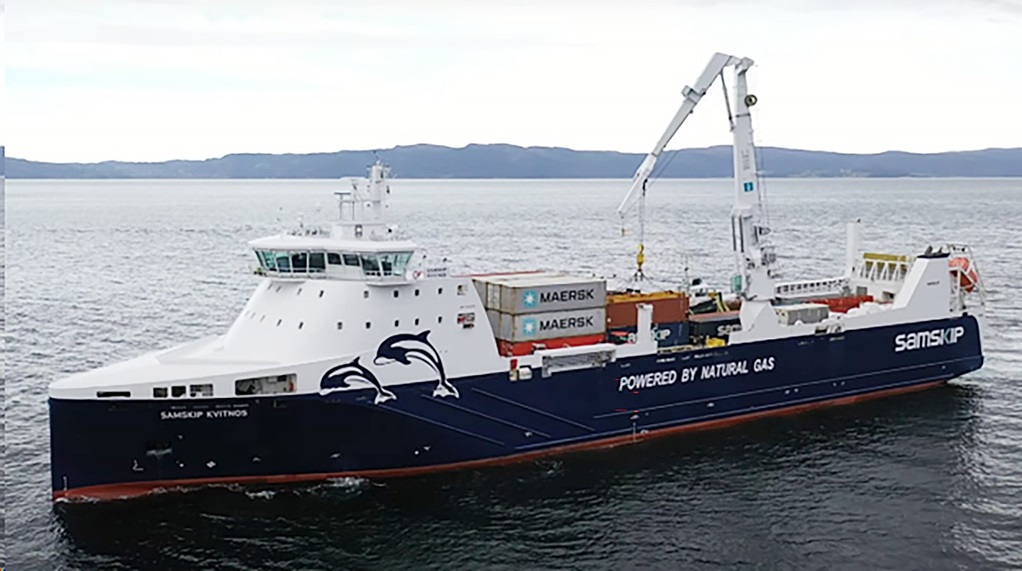Samskip to announce its partnership in the groundbreaking HyEkoTank project, an initiative supported by the European Union’s Horizon Europe program. As part of its ongoing efforts to reach net zero emissions by 2040, Samskip will retrofit its multipurpose vessel Samskip Kvitnos with cutting-edge hydrogen fuel cell technology developed by TECO 2030. This collaboration will enable Samskip to take another major step forward in decarbonizing its fleet and reducing greenhouse gas emissions.
The Samskip Kvitnos operates on a fixed route from Rotterdam along the Norwegian west coast to Hammerfest, making it a vital part of Samskip’s commitment to sustainable logistics in one of Europe’s most environmentally sensitive regions. By retrofitting this vessel with zero-emission fuel cells, Samskip will ensure the Samskip Kvitnos stays ahead of upcoming regulations, including the FuelEU Maritime and EU Emissions Trading System (EU ETS), while also addressing the need for zero emissions in Norwegian world heritage fjords by 2030.
Participation in the HyEkoTank project is the latest in a series of Samskip initiatives aimed at reducing carbon emissions across the maritime sector. From its pioneering Seashuttle project, which is building hydrogen-powered container ships, to its use of biofuels, shore power and CO2 capture systems, Samskip is dedicated to leveraging advanced technologies and innovative partnerships to meet its ambitious decarbonization targets.
“We have spent years actively pursuing sustainable solutions across our fleet, and this retrofit of the Samskip Kvitnos aligns perfectly with our vision for the future of shipping,” said Erik Hofmeester, Head of Vessel Management at Samskip. “Working alongside TECO 2030 and the HyEkoTank consortium, we are ensuring that the Kvitnos not only meets but stays ahead of the zero-emission targets set by the EU and Norwegian authorities, all while continuing to provide reliable service for our customers.”
Future-Proofing the Samskip Fleet
The HyEkoTank project is the world’s largest ongoing fuel cell retrofit effort, demonstrating the potential of hydrogen technology in reducing emissions in the global maritime sector. For Samskip, retrofitting the Samskip Kvitnos is not just about compliance—it’s about future-proofing its fleet to meet the energy needs of tomorrow while delivering tangible environmental benefits today.
“Our collaboration with TECO 2030 is a key part of our journey to achieving net zero by 2040,” Hofmeester continued. “By investing in retrofitting existing vessels like the Samskip Kvitnos, we are maximizing the environmental impact of our operations while ensuring long-term sustainability and competitiveness in a rapidly evolving industry.”
A Joint Commitment to Green Shipping
Samskip’s inclusion in the HyEkoTank project is further supported by other renowned partners, including Shell, Umoe Advanced Composites, and the Arctic University of Norway. Together, the consortium will implement advanced technologies that enable zero-emission navigation in European coastal areas and the Norwegian fjords, safeguarding these regions for future generations.
The Samskip Kvitnos retrofit is scheduled for completion in 2025 and is expected to significantly reduce emissions while maintaining operational efficiency on Samskip’s established routes.
Source: Samskip.
Tags: Samskip, Shipping, TECO 2030, ZeroEmission



Recent Posts
ZeroNorth’s SMARTShip platform integrates with ClassNK MRV portal to automate emissions reporting
Towngas Partners with TLB, Pacific Basin to Advance Green Marine Fuel Infrastructure in Hong Kong
SECI Extends Bid Deadline for Green Ammonia Tender Under SIGHT Scheme
Greenzo Energy Bags ₹320 Cr Order from Oswal Energies for 20 MW Green Hydrogen Plant in Gujarat
Toyota Kirloskar and Ohmium International Join Forces to Develop Green Hydrogen Solutions in India
EST-Floattech Expands Octopus Series with Lithium Iron Phosphate Battery Modules
PowerCell’s Marine System 225 receives Type Approval from Lloyd’s Register
Echandia Secures SEK 325 Million in Funding to Advance Maritime Electrification